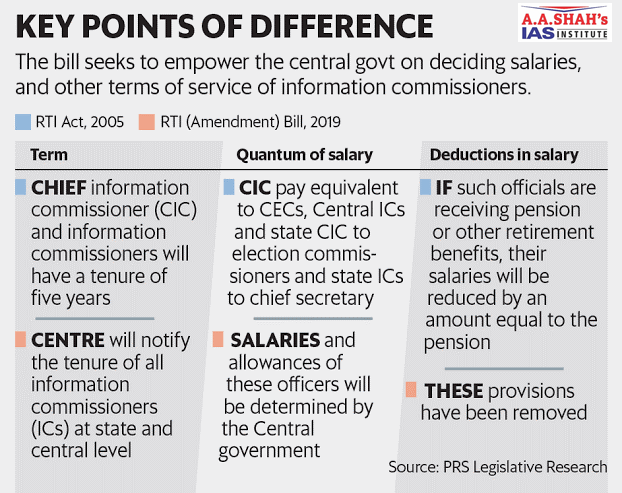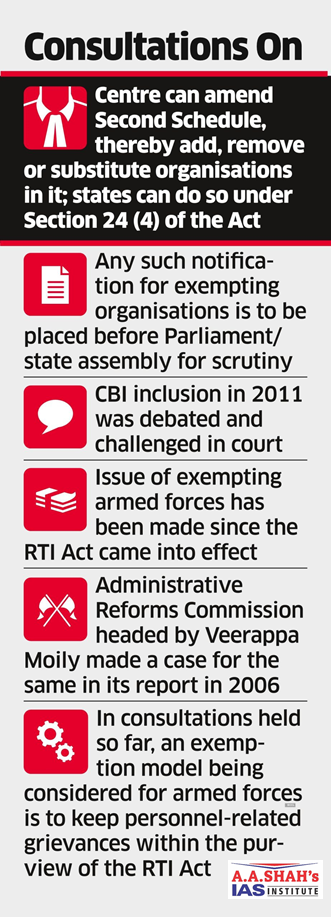20 years of RTI Act, 2005
POLITY – BILL/ACT
12 OCTOBER 2025
The Right to Information (RTI) Act, 2005 completes 20 years of implementation in October 2025.
Information disclosure in India had traditionally been restricted by the Official Secrets Act 1923 and various other special laws, which the new RTI Act overrides
It replaced the former Freedom of Information Act, 2002.
Under the provisions of the Act, any citizen of India may request information from a “public authority” (a body of Government or “instrumentality of State”) which is required to reply expeditiously or within thirty days.
In case of the matter involving a petitioner’s life and liberty, the information has to be provided within 48 hours.
It covers all the constitutional authorities, including executive, legislature and judiciary; any institution or body established or constituted by an act of Parliament or a state legislature.
Bodies or authorities established or constituted by order or notification of appropriate government including bodies “owned, controlled or substantially financed” by government, including Non-Government Organizations (NGOs) come within the purview of RTI Act.
The Act also requires every public authority to computerize their records for wide dissemination and to proactively publish certain categories of information so that the citizens need minimum recourse to request information formally.
The Public Information Officer (PIO) or the First Appellate Authority in the public authorities perform quasi-judicial function of deciding on the application and appeal respectively.
Political Parties and RTI
The Central Information Commission (CIC) held in June 2013, that the political parties are public authorities and are answerable to citizens under the RTI Act.
The CIC said that eight national parties – Congress, BJP, NCP, CPI(M), CPI, BSP, NPP and AITC – has been substantially funded indirectly by the Central Government and have the character of public authorities under the RTI Act as they perform public functions.
But in August 2013 the government introduced a Right to Information (Amendment) Bill which would remove political parties from the scope of the law.
RTI amendment Act, 2019
Originally under the RTI Act, 2005, the Chief Information Commissioner and Information Commissioners served for 5 years or until age 65, whichever is earlier and their salary and terms of service matched those of the Chief Election Commissioner and Election Commissioners.
However, the 2019 amendment changed this, giving the Central Government the power to set their term of office, salaries, allowances, and terms of service.
Achievements of the RTI Act
1. Promoted Transparency and Accountability
The RTI Act has made government departments more open and answerable to the public.
Example: Citizens have used RTI to get details about how government funds are spent in local development projects like road construction, school repairs, and health programs.
2. Empowered Citizens
The Act gives every Indian the legal right to ask for information from government offices.
Example: In rural areas, people have used RTI to find out why their names were missing from ration card or pension lists, and ensured corrections were made.
In Andhra Pradesh, villagers used RTI to verify lists of people receiving employment under the MGNREGA scheme and found several fake names removed.
3. Strengthened Democracy
RTI allows citizens to question those in power, reinforcing the principle that government must serve the people.
Example: Voters have used RTI to check educational qualifications and criminal records of candidates standing for election.
4. Helped Expose Corruption
RTI has been a powerful tool to uncover scams and misuse of public money.
Examples:
Adarsh Housing Scam (Maharashtra): RTI activists exposed how flats meant for war widows were allotted to politicians and officers.
Commonwealth Games Scam (2010): RTI queries helped reveal irregularities in contracts and expenses.
Public Distribution System (PDS): In states like Bihar and Rajasthan, people used RTI to expose fake ration cards and diversion of food grains.
5. Improved Government Efficiency
Knowing that their work can be examined, many officials now keep records properly and make decisions carefully.
Example: Many government websites now display information like budgets, tenders, and welfare scheme details proactively (as per Section 4 of the RTI Act).
6. Supported Investigative Journalism
Journalists use RTI to obtain authentic government data and expose wrongdoing.
Example: RTI applications have helped uncover irregularities in school mid-day meal schemes, environmental clearances, and police recruitment processes.
Challenges Facing the RTI Act
1. Delay in Providing Information
Many public authorities do not respond within the 30-day time limit.
Reason: Lack of staff, poor record management, and deliberate delay by officials.
2. Delay in Appeals and Complaints
State and Central Information Commissions have huge backlogs of cases.
In most Information Commissions (ICs), the waiting time to resolve a matter exceeds one year. In some states, the delays are extreme, with Telangana estimated at 29 years and 2 months and Tripura at 23 years.
3. Vacant Positions:
Between 2023 and 2024, six Information Commissions were completely defunct for varying periods due to the non-appointment of new commissioners.
Currently, the Jharkhand and Himachal Pradesh commissions are defunct, while the Central Information Commission (CIC), Chhattisgarh, and Andhra Pradesh commissions function without a Chief Information Commissioner.
4. Poor Record-Keeping and Digitization
Government departments often maintain outdated or disorganized records.
This makes it difficult to locate and share information quickly.
5. Misuse of the Act
Some individuals file RTI requests for personal or frivolous reasons.
This increases the workload of public officials and wastes time.
6. Weak Protection for RTI Activists
Several RTI activists who exposed corruption have been threatened or attacked, and in some cases, even killed.
Example: Activists like Satish Shetty and Shehla Masood lost their lives for exposing corruption through RTI.
7. Increasing Secrecy Clauses
Some amendments and circulars have made it harder to access information from certain offices (especially in security and finance sectors).
This goes against the spirit of transparency.
8. Political and Bureaucratic Resistance
Political pressure sometimes discourages officials from revealing sensitive data.
The RTI Amendment Act, 2019 reduced Information Commissioners’ autonomy by giving the Central Government power to set their tenure and salaries.

